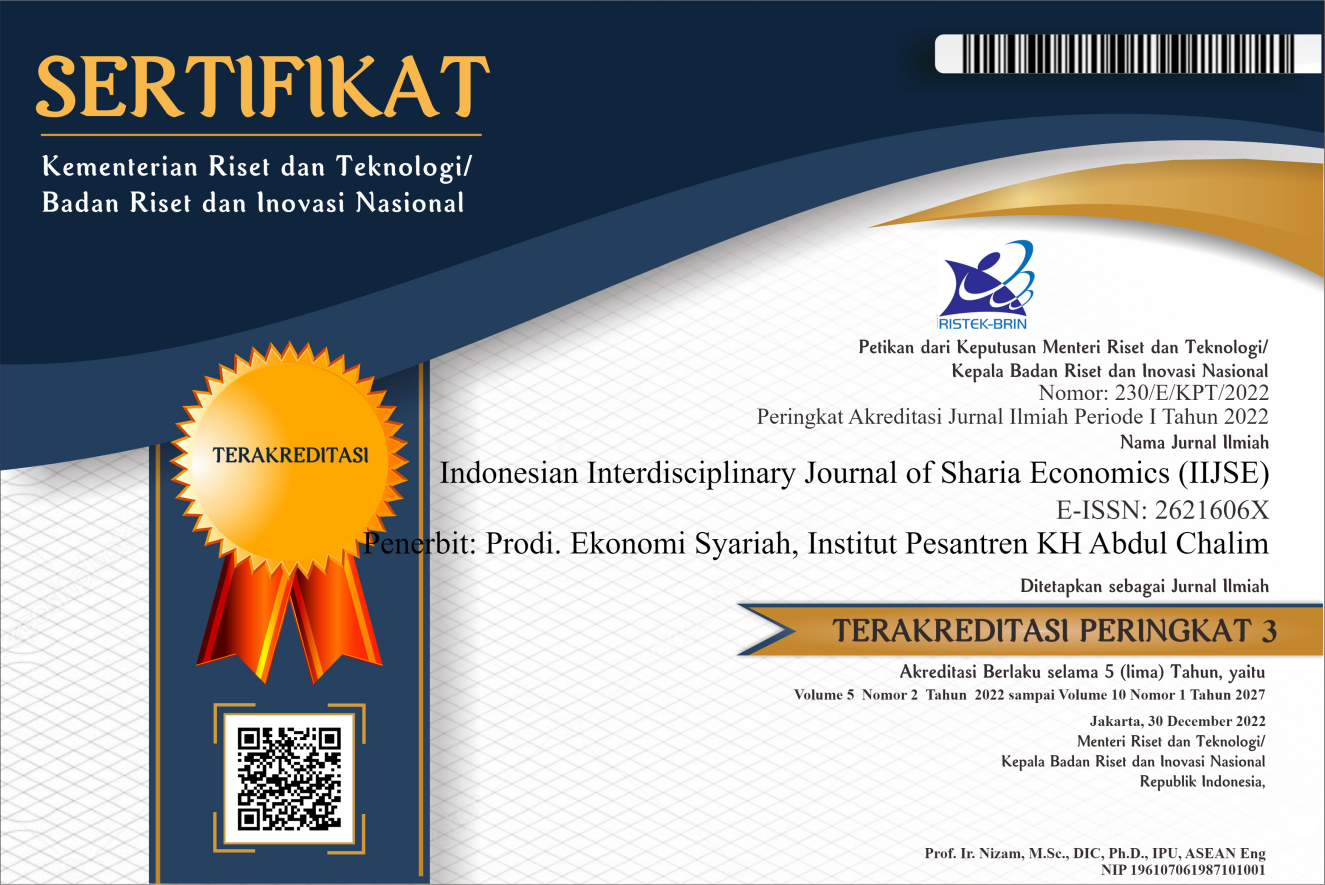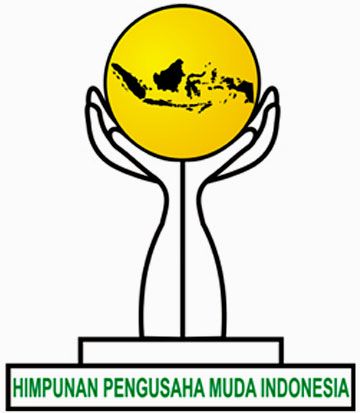The Role of Physical, Social, and Financial Infrastructure on Economic Growth in Indonesia
Abstract
The purpose of this research is to determine the effects of physical, social, and financial infrastructure on economic growth in Indonesia during 2016-2020 using data from 34 provinces. The infrastructure index is compiled using the Principal Component Analysis (PCA) technique to represent infrastructure indicators. Estimation in this study was carried out using the Panel Corrected Standard Error (PCSE) to improve the Fixed Effect Model which contains problems of multicollinearity, heteroscedasticity, and autocorrelation. The results of this study show that physical infrastructure, social infrastructure, and financial infrastructure have a significant impact on economic growth in Indonesia. Physical and social infrastructure has a positive impact, while financial infrastructure has a negative impact.
Downloads
References
Adam, M., Batubara, M., & Bi Rahmani, N. (2023). The Impact of HGU Land Conversion on Community Socio-Economy from An Islamic Economic Perspective. Indonesian Interdisciplinary Journal of Sharia Economics (IIJSE), 6(3), 3243-3259. https://doi.org/10.31538/iijse.v6i3.4009
Adekoya, A. F. (2019). Income Inequality and Violent Crime in Nigeria: A Panel Corrected Standard Error Approach. Ibadan Journal of Peace & Development, 9(2), 1-10.
Agénor, P. R., & Moreno-Dodson, B. (2006). Public infrastructure and growth: New channels and policy implications (Vol. 4064). World Bank Publications.
Allison, P. D. (2009). Fixed effects regression models. SAGE publications.
Amrullah, T. (2006). Analisis Pengaruh Pembangunan Infrastruktur Terhadap Pertumbuhan Ekonomi Indonesia. Depok: Tesis Program MPKP Fakultas Ekonomi Universitas Indonesia. Depok.
Arif, U., Javid, M., & & Khan, F. N. (2021). Productivity impacts of infrastructure development in Asia. Economic Systems, 45(1), 100851.
Aschauer, D. A. (1989). Is public expenditure productive? Journal of monetary economics, 23(2), 177-200. Baltagi, B. H. (2015). Econometric Analysisof Panel Data (5th Ed.). Chicester: John Wiley & Sons Ltd.
Barro, R. J. (1990). Government spending in a simple model of endogeneous growth. Journal of political economy, 98(5, Part 2), S103-S125.
Beck, N., & Katz, J. N. (1995). What to do (and not to do) with time-series cross-section data. American political science review, 89(3), 634-647.
Boyreau-Debray, G. (2003). Financial Intermediation and Growth: Chinese Style. The World Bank, Policy Research Working Paper Series 3027.
BPS. (2016). Statistik Indonesia 2016. Jakarta: Badan Pusat Statistik.
BPS. (2016). Statistik Transportasi Darat 2016. Jakarta: Badan Pusat Statistik. BPS. (2016). Statistik Transportasi Laut 2016. Jakarta: Badan Pusat Statistik. BPS. (2016). Statistik Transportasi Udara2016. Jakarta: Badan Pusat Statistik.
BPS. (2017). Statistik Indonesia 2017. Jakarta: Badan Pusat Statistik.
BPS. (2017). Statistik Transportasi Darat 2017. Jakarta: Badan Pusat Statistik. BPS. (2017). Statistik Transportasi Laut 2017. Jakarta: Badan Pusat Statistik. BPS. (2017). Statistik Transportasi Udara 2017. Jakarta: Badan Pusat Statistik. BPS. (2018). Statistik Indonesia 2018. Jakarta: Badan Pusat Statistik.
BPS. (2018). Statistik Transportasi Darat 2018. Jakarta: Badan Pusat Statistik. BPS. (2018). Statistik Transportasi Laut 2018. Jakarta: Badan Pusat Statistik. BPS. (2018). Statistik Transportasi Udara 2018. Jakarta: Badan Pusat Statistik. BPS. (2019). Statistik Indonesia 2019. Jakarta: Badan Pusat Statistik.
BPS. (2019). Statistik Transportasi Darat 2019. Jakarta: Badan Pusat Statistik. BPS. (2019). Statistik Transportasi Laut 2019. Jakarta: Badan Pusat Statistik. BPS. (2019). Statistik Transportasi Udara 2019. Jakarta: Badan Pusat Statistik. BPS. (2020). Statistik Indonesia 2020. Jakarta: Badan Pusat Statistik.
BPS. (2020). Statistik Transportasi Darat 2020. Jakarta: Badan Pusat Statistik. BPS. (2020). Statistik Transportasi Laut 2020. Jakarta: Badan Pusat Statistik. BPS. (2020). Statistik Transportasi Udara 2020. Jakarta: Badan Pusat Statistik. BPS. (2021). Statistik Indonesia 2021. Jakarta: Badan Pusat Statistik.
Brilyawan, K., & Santosa, P. B. (2021). Pengaruh Infrastruktur Sosial Dan Ekonomi Terhadap Pertumbuhan Ekonomi Indonesia Tahun 2015-2019. Diponegoro Journal of Economics, 10(1).
Buhaerah, P. (2017). Pembangunan Keuangan dan Pertumbuhan Ekonomi: Studi Kasus Indonesia. Kajian Ekonomi dan Keuangan, 1(2), 165-180.
Calderón, C., & Servén, L. (2008). Infrastructure and economic development in Sub-Saharan Africa. Policy Research Working Paper 4712. The World Bank.
Canning, D., & Pedroni, P. (2004). The effect of infrastructure on long run economic growth. Harvard University, 99(9), 1-30.
Cojocaru, L., Falaris, E. M., Hoffman, S. D., & Miller, J. B. (2016). Financial system development and economic growth in transition economies: New empirical evidence from the CEE and CIS countries. Emerging Markets Finance and Trade, 52(1), 223-236.
Dash, R. K., & Sahoo, P. (2010). Economic growth in India: the role of physical and social infrastructure. Journal of Economic Policy Reform, 13(4), 373-385.
Dissou, Y., & Didic, S. (2013). Infrastructure and growth. In Infrastructure and Economic Growth in Asia (pp. 5-45). Springer, Cham.
Durusu-Ciftci, D., Ispir, M. S., & Yetkiner, H. (2017). Financial development and economic growth: Some theory and more evidence. Journal of policy modeling, 39(2), 290-306.
Estache, A., & Fay, M. (2009). Current debates on infrastructure policies. Washington: Commission on Growth and Development.
Fedderke, J. W., & Bogetić, Ž. (2009). Infrastructure and growth in South Africa: Direct and indirect productivity impacts of 19 infrastructure measures. World Development, 37(9), 1522-1539.
Gangl, M. (2010). Causal Inference in Sociological Research. Annual Review of Sociology, 36:21-47.
Garcia-Mila, T., McGuire, T. J., & & Porter, R. H. (1996). The effect of public capital in state-level production functions reconsidered. The review of economics and statistics, 177-180.
Ghosh, B., & De, P. (2004). How do different categories of infrastructure affect development? Evidence from Indian states. Economic and Political Weekly, 4645-4657.
Gramlich, E. M. (1994). Infrastructure investment: A review essay. Journal of economic literature, 32(3), 1176-1196.
Greene, W. H. (2003). Econometric analysis. Pearson Education India.
Hall, R. E. (1999). Why do some countries produce so much more output per worker than others? The quarterly journal of economics, 114(1), 83-116.
Hill, T. D., Davis, A. P., Roos, J. M., & & French, M. T. (2020). Limitations of fixed-effects models for panel data. Sociological Perspectives, 63(3), 357-369.
Holtz-Eakin, D., & Schwartz, A. E. (1995). Infrastructure in a structural model of economic growth. Regional Science and Urban Economics, 25(2), 131-151.
IMD. (2021). IMD World Competitiveness Yearbook 2021. Lausanne: International Institute for Management Development.
Inggrid. (2006). Sektor Keuangan dan Pertumbuhan Ekonomi di Indonesia: Pendekatan Kausalitas dalam Multivariate Vector Error Correction Model (VECM). Jurnal Manajemen dan Kewirausahaan, Jurnal Manajemen dan Kewirausahaan.
Irawan, R., & Iskandar, D. D. (2019). Analysis Of Infrastructure Effect On Indonesia's Economic Growth Year 2007-2014. AFEBI Economic and Finance Review, 4(02), 121-130.
Jedidia, K. B., Boujelbène, T., & Helali, K. (2014). Financial development and economic growth: New evidence from Tunisia. Journal of Policy Modeling, 36(5), 883-898.
Jolliffe, I. T. (1972). Discarding variables in a principal component analysis. I: Artificial data. Journal of the Royal Statistical Society: Series C (Applied Statistics), 21(2), 160-173.
Kaiser, H. F. (1960). The Application Of Electronic Computers To Factor Analysis. Educational And Psychological Measurement, 20(1), 141-151.
Kemendikbud. (2021, 12). Data Pokok Pendidikan. Retrieved from Dapodik: https://dapo.kemdikbud.go.id/ Kemenkes. (2016). Profil Kesehatan Indonesia 2016. Jakarta: Kementerian Kesehatan Republik Indonesia.
Kemenkes. (2017). Profil Kesehatan Indonesia 2017. Jakarta: Kementerian Kesehatan Republik Indonesia. Kemenkes. (2018). Profil Kesehatan Indonesia 2018. Jakarta: Kementerian Kesehatan Republik Indonesia. Kemenkes. (2019). Profil Kesehatan Indonesia 2019. Jakarta: Kementerian Kesehatan Republik Indonesia. Kemenkes. (2020). Profil Kesehatan Indonesia 2020. Jakarta: Kementerian Kesehatan Republik Indonesia.
Kemenristekdikti. (2017). Statistik Pendidikan Tinggi 2017. Jakarta: Sekretaris Direktorat Jenderal Pendidikan Tinggi.
Kemenristekdikti. (2018). Statistik Pendidikan Tinggi 2018. Jakarta: Sekretaris Direktorat Jenderal Pendidikan Tinggi.
Kemenristekdikti. (2019). Statistik Pendidikan Tinggi 2019. Jakarta: Sekretaris Direktorat Jenderal Pendidikan Tinggi.
Kemenristekdikti. (2020). Statistik Pendidikan Tinggi 2020. Jakarta: Sekretaris Direktorat Jenderal Pendidikan Tinggi.
Kharisma, B., & Nuraeny, V. (2018). Infrastruktur dan Output Perkapita Antar Provinsi di Indonesia. Media Trend, 13(2), 277-290.
Khurriah, H., & Istifadah, N. (2019). The Role of Infrastructure in Indonesia’s Economic Growth. International Journal of Advances in Scientific Research and Engineering, 5(7), 215-222.
Kodongo, O., & Ojah, K. (2016). Does infrastructure really explain economic growth in Sub-Saharan Africa? Review of Development Finance, 6(2), 105-125.
Kumari, A., & Sharma, A. K. (2017). Physical & social infrastructure in India & its relationship with economic development. World Development Perspectives, 5, 30-33.
Kustanto, A. (2020). Pertumbuhan Ekonomi Regional di Indonesia: Peran Infrastruktur, Modal Manusia dan Keterbukaan Perdagangan (Regional Economic Growth in Indonesia: The Role of Infrastructure, Human Capital and Trade Openness). Buletin Studi Ekonomi, 25(1).
Lall, S. V. (2007). Infrastructure and regional growth, growth dynamics and policy relevance for India. Annals of Regional Science, 41(3), 581-599.
Law, S. H., & Singh, N. (2014). Does too much finance harm economic growth? Journal of Banking & Finance, 41, 36-44.
Mankiw, N. G., Romer, D., & Weil, D. N. (1992). A contribution to the empirics of economic growth. The quarterly journal of economics, 107(2), 407-437.
Maryaningsih, N., Hermansyah, O., & Savitri, M. (2014). Pengaruh infrastruktur terhadap pertumbuhan ekonomi Indonesia. Buletin Ekonomi Moneter dan Perbankan, 17(1), 62-98.
Maski, G. (2010). Analisis Kausalitas antara Sektor Keuangan dan Pertumbuhan Ekonomi di Indonesia. Jurnal Ekonomi dan Pembangunan Indonesia, 10(2), 143-158.
Mitra, A., Varoudakis, A., & Veganzones-Varoudakis, M. A. (2002). Productivity and technical efficiency in Indian states’ manufacturing: the role of infrastructure. Economic development and cultural change, 50(2), 395-426.
Munnell, A. H. (1992). Policy watch: infrastructure investment and economic growth. Journal of economic perspectives, 6(4), 189-198.
Nugraha, A. T., Prayitno, G., Situmorang, M. E., & Nasution, A. (2020). The Role of Infrastructure in Economic Growth and Income Inequality in Indonesia. Economics & Sociology, 13(1), 102-115.
OJK. (2016). Statistik Perbankan Indonesia 2016. Jakarta: Otoritas Jasa Keuangan. OJK. (2017). Statistik Perbankan Indonesia 2017. Jakarta: Otoritas Jasa Keuangan. OJK. (2018). Statistik Perbankan Indonesia 2018. Jakarta: Otoritas Jasa Keuangan. OJK. (2019). Statistik Perbankan Indonesia 2019. Jakarta: Otoritas Jasa Keuangan. OJK. (2020). Statistik Perbankan Indonesia 2020. Jakarta: Otoritas Jasa Keuangan.
Radiansyah, D. (2012). Analisis Kontribusi Infrastruktur Terhadap Pertumbuhan Ekonomi Regional di Indonesia (Periode Tahun 1996 sd 2008). Jakarta: Tesis Program Magister Perencanaan dan Kebijakan Publik. Universitas Indonesia.
Sahoo, P. (2006). Foreign direct investment in South Asia: Policy, trends, impact and determinants. ADB Institute Discussion Paper No. 56.
Sahoo, P., Dash, R. K., & Nataraj, G. (2012). China's growth story: The role of physical and social infrastructure. Journal of Economic Development, 37(1), 53.
Saygili, H., & Ozdemir, K. A. (2020). Regional economic growth in Turkey: the effects of physical, social and financial infrastructure investment. Empirical Economics, 60(4), 2039-2061.
Sibarani, M. H. (2002). Kontribusi Infrastruktur terhadap Pertumbuhan Ekonomi Indonesia. Jakarta: Tesis Magister Sains. Program Pascasarjana, Universitas Indonesia.
Sugiyarto, A. (2015). The Importance of Infrastructure Development for Regional Economic Growth in Indonesia. Depok: Master Tesis Study Program in Economics. University of Indonesia.
Surgawati, I. (2020). Pengeluaran Pemerintah Dan Pertumbuhan Ekonomi: Hipotesis Keynes Versus Teori Wagner. Welfare Jurnal Ilmu Ekonomi, 1(1).
Uddin, M. N., Islam, A. S., Bala, S. K., Islam, G. T., Adhikary, S., Saha, D., & Akter, R. (2019). Mapping of climate vulnerability of the coastal region of Bangladesh using principal component analysis. Applied geography, 102, 47-57.
UNCTAD. (2021). World Investment Report 2021: Investing in Sustainable Recovery. New York: United Nations Publications.
Witkowska, M. (2006). Fundamentals and stock returns on the Warsaw Stock Exchange: the application of panel data models. Department of Applied Econometrics Working Paper, (4-06).
World Bank. (1994). World development report 1994: Infrastructure for development. New York: Oxford University Press, Inc.
Yi, M. (2019). Application of Principal Component Analysis in Teaching Evaluation. Frontiers in Sport Research, 1(1).
Copyright (c) 2024 Anggara Wahyu Adhari, Khoirunurrofik Khoirunurrofik

This work is licensed under a Creative Commons Attribution-ShareAlike 4.0 International License.
Authors who publish with this journal agree to the following terms:
- Authors retain copyright and grant the journal right of first publication with the work simultaneously licensed under a Creative Commons Attribution License that allows others to share the work with an acknowledgment of the work's authorship and initial publication in this journal.
- Authors are able to enter into separate, additional contractual arrangements for the non-exclusive distribution of the journal's published version of the work (e.g., post it to an institutional repository or publish it in a book), with an acknowledgment of its initial publication in this journal.
- Authors are permitted and encouraged to post their work online (e.g., in institutional repositories or on their website) prior to and during the submission process, as it can lead to productive exchanges, as well as earlier and greater citation of published work.


















